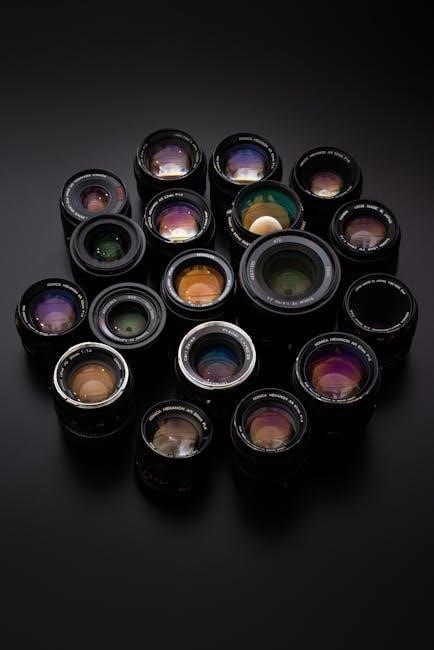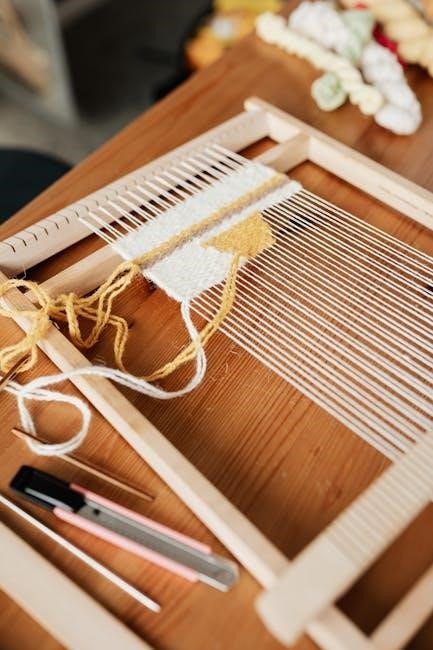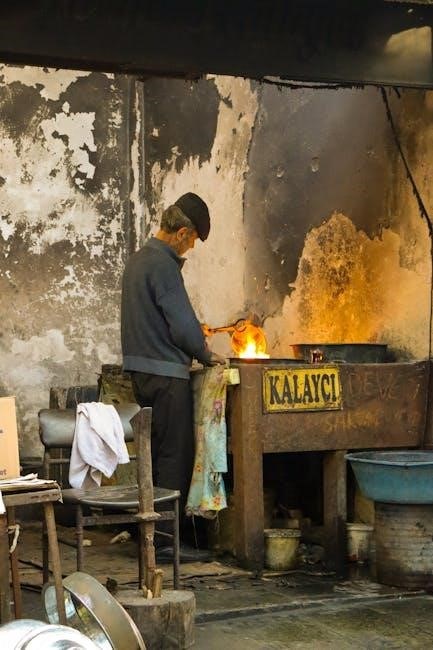Dreo Heater Manual: A Comprehensive Guide
Welcome to your comprehensive guide to understanding and utilizing your Dreo heater! This manual provides valuable information, from initial setup and safety precautions to advanced features and troubleshooting tips, ensuring optimal performance and safety. Explore the full potential of your Dreo heater!

Understanding Your Dreo Heater Model
Before diving into operation, familiarizing yourself with your specific Dreo heater model is crucial. Dreo offers a range of heaters, each with unique features and capabilities. Identifying your model number, typically found on a label located on the heater’s base or back, allows you to access the correct user manual and specifications.
Different models may incorporate varying heating technologies, such as PTC ceramic heating elements or oil-filled radiators. PTC ceramic heaters, known for their rapid heating and energy efficiency, are commonly found in portable Dreo models. Oil-filled radiators, on the other hand, provide consistent and radiant heat, often with enhanced safety features.
Understanding your model’s power output, typically measured in watts (e.g., 1500W), is essential for determining its heating capacity and energy consumption. Features like oscillation, adjustable thermostats, and remote control functionality also vary across models. Consulting your user manual provides detailed insights into your heater’s specific features, ensuring you can optimize its performance and safety.
Reviewing the manual will also highlight any unique safety features or operational nuances specific to your model. This knowledge empowers you to use your Dreo heater effectively and confidently.
Initial Setup and Safety Precautions
Prior to operating your Dreo heater, a proper initial setup is crucial for safety and optimal performance. Begin by carefully unpacking the heater and ensuring all components, including the remote control (if applicable) and user manual, are present. Inspect the heater for any visible damage that may have occurred during shipping. If damage is detected, contact Dreo support immediately.
Place the heater on a firm, level surface, away from flammable materials such as curtains, bedding, or furniture. Maintain a minimum clearance of three feet around the heater to prevent fire hazards. Never operate the heater in areas with high humidity, such as bathrooms or laundry rooms.
Before plugging in the heater, ensure that the power outlet is compatible with the heater’s voltage and amperage requirements, as specified in the user manual. Avoid using extension cords whenever possible, as they can overheat and pose a fire risk. If an extension cord is necessary, use a heavy-duty cord rated for the heater’s power consumption.
Always read and understand the user manual thoroughly before operating the heater. Pay close attention to all safety warnings and instructions. Registering your product with Dreo can also provide access to important safety updates and support resources.
Operating Instructions: Basic Functions

Once your Dreo heater is properly set up, familiarize yourself with the basic operating functions. To power on the heater, press the power button located on the control panel or remote control. The LED display will illuminate, indicating the current settings.
Adjust the desired temperature using the “+” and “-” buttons. The temperature range is typically between 41°F and 95°F. The heater will automatically select its optimal heating power, depending on the difference between the set temperature and the ambient temperature. For faster heating, select a higher temperature setting. To maintain a consistent temperature, choose a setting that is comfortable for your environment.
Many Dreo heaters feature multiple heating modes, such as low, medium, and high. Select the appropriate mode based on your heating needs. Low mode is ideal for maintaining a comfortable temperature in a small space, while high mode is suitable for quickly heating a larger area.
To power off the heater, press the power button again. The heater may continue to run for a short period to cool down the internal components. Always allow the heater to cool completely before storing it.
Advanced Features: Timer and Oscillation
Dreo heaters often come equipped with advanced features designed to enhance user experience and convenience. Two prominent features are the timer function and oscillation mode. The timer function allows you to set a specific duration for the heater to operate, enabling automatic shut-off after a desired period;
To set the timer, press the timer button on the control panel or remote. Use the “+” and “-” buttons to adjust the timer duration, typically ranging from 1 to 12 hours. Once the set time has elapsed, the heater will automatically power off, conserving energy and providing peace of mind. This feature is particularly useful for nighttime use or when you want to preheat a room before arrival.
The oscillation mode enables the heater to rotate horizontally, distributing heat evenly across a wider area. To activate oscillation, press the oscillation button, often indicated by a fan icon. The heater will begin to oscillate, providing consistent warmth throughout the room. To stop oscillation, press the button again. Oscillation is beneficial for larger spaces or when multiple people require heating.
Experiment with these features to customize your heating experience.
Remote Control Functionality
Many Dreo heater models include a remote control, offering convenient operation from a distance. The remote typically mirrors the control panel functions on the heater itself, allowing you to adjust settings without needing to be near the unit. The remote control usually includes buttons for power on/off, temperature adjustment, mode selection (e.g., high, low, eco), timer settings, and oscillation control.
To use the remote control, insert batteries (typically AAA) into the battery compartment, ensuring correct polarity. Point the remote towards the heater’s receiver, usually located on the front panel. Press the desired button to activate the corresponding function. Ensure there are no obstructions between the remote and the heater for optimal signal transmission.
The remote control provides added convenience, especially when adjusting settings from across the room or when the heater is placed in a hard-to-reach location. Some remotes may also include additional features, such as a display screen that mirrors the heater’s display. Familiarize yourself with the specific functions of your remote model for seamless operation.
Always replace batteries when they are low to ensure proper functionality.
Cleaning and Maintenance
Proper cleaning and maintenance are crucial for ensuring the longevity and efficient operation of your Dreo heater. Before cleaning, always disconnect the heater from the power outlet and allow it to cool down completely. Use a soft, damp cloth to wipe down the exterior surfaces of the heater. Avoid using abrasive cleaners, solvents, or scouring pads, as these can damage the finish.
Pay particular attention to the air intake and outlet vents. Dust and debris can accumulate in these areas, restricting airflow and reducing heating efficiency. Use a vacuum cleaner with a brush attachment to gently remove any accumulated dust. For stubborn debris, a soft brush or cotton swab can be used.
Regularly inspect the power cord for any signs of damage, such as fraying or cracking. If the power cord is damaged, discontinue use and contact Dreo customer support for assistance. Do not attempt to repair the power cord yourself. Store the heater in a cool, dry place when not in use. Cover the heater with a cloth or plastic bag to protect it from dust and dirt.
With proper care and attention, your Dreo heater will provide reliable and efficient heating for years to come.

Troubleshooting Common Issues
Encountering issues with your Dreo heater? This section addresses common problems and offers potential solutions. If your heater isn’t turning on, first ensure it’s properly plugged into a functioning outlet. Check the power cord for damage and verify the power switch is in the “on” position. If the heater still doesn’t power up, examine your home’s circuit breaker to rule out any tripped circuits.
If the heater turns on but isn’t producing heat, confirm the thermostat is set to your desired temperature. Ensure the heater isn’t in “fan only” mode. Obstructions blocking the air intake or outlet vents can also hinder heat output; clear any obstructions. Should the heater overheat and shut off, unplug it and allow it to cool completely before attempting to restart it. Check for and remove any obstructions that may have caused the overheating.
For unusual noises, ensure the heater is placed on a stable, level surface. Loose components can sometimes cause rattling; contact customer support if the noise persists. If the heater displays an error code, consult the “Dreo Heater Error Codes and Solutions” section of this manual for specific troubleshooting steps. If problems continue, contacting Dreo customer support is recommended.
Safety Features: Overheat and Tip-Over Protection
Your Dreo heater is equipped with multiple safety features to ensure secure operation. Overheat protection is a crucial component, preventing the unit from reaching dangerously high temperatures. If the internal temperature exceeds a pre-set limit, the heater will automatically shut off. This feature safeguards against potential fire hazards and damage to the unit itself. To reset after an overheat event, unplug the heater, allow it to cool completely, and then remove any obstructions that may have blocked airflow.
Tip-over protection is another essential safety measure. The heater is designed with a built-in sensor that detects if it is accidentally knocked over or tilted beyond a certain angle. In such instances, the heater will immediately cease operation, minimizing the risk of fire or injury. To resume use after a tip-over, simply place the heater back in an upright position on a stable, level surface. Ensure the area around the heater is clear of obstructions that could contribute to tipping.
These features work in tandem to provide a safe heating experience, offering peace of mind while using your Dreo heater.
Dreo Heater Error Codes and Solutions
Dreo heaters are designed with a user-friendly interface that includes error codes to help diagnose potential issues. These codes appear on the LED display and provide valuable information about the heater’s operational status. Understanding these codes can save you time and effort in troubleshooting common problems.
One common error code is “E1” or “E2,” which typically indicates an overheat situation. As mentioned earlier, this can occur if the heater’s airflow is obstructed or if the internal temperature rises excessively. The solution is to unplug the heater, let it cool down completely, and ensure that the vents are clear of any obstructions. Another potential error code is “F0” which might signify a sensor malfunction. In this case, it is advisable to contact Dreo’s customer support for assistance.
Some models may display error codes related to tip-over protection. If the heater tips over, it might show an error until it’s placed back in an upright position. Always refer to your specific model’s manual for a comprehensive list of error codes and their corresponding solutions. If you are unable to resolve the issue using the troubleshooting steps provided, reaching out to Dreo’s support team is the best course of action to ensure safe and effective operation of your heater.

Warranty and Support Information
Your Dreo heater comes with a manufacturer’s warranty that protects against defects in materials and workmanship. The warranty period typically lasts for one year from the date of purchase. To ensure your warranty is valid, it’s essential to register your product on the Dreo website or through the Dreo app. This will also allow you to receive important updates and support information.
In the event that you experience any issues with your Dreo heater during the warranty period, Dreo offers comprehensive support services. Their customer support team can be reached via email at uk-support@dreo.com, as indicated in some online resources. Before contacting support, it’s helpful to have your model number, purchase date, and a detailed description of the problem ready;
Dreo’s support resources also include online manuals, FAQs, and troubleshooting guides. These resources can often provide quick answers to common questions. If you need to return your heater for repair or replacement under warranty, follow the instructions provided by Dreo’s customer support. Be sure to retain your original proof of purchase and packaging materials, as these may be required for warranty claims. Dreo is committed to providing excellent customer service and ensuring your satisfaction with their products.
